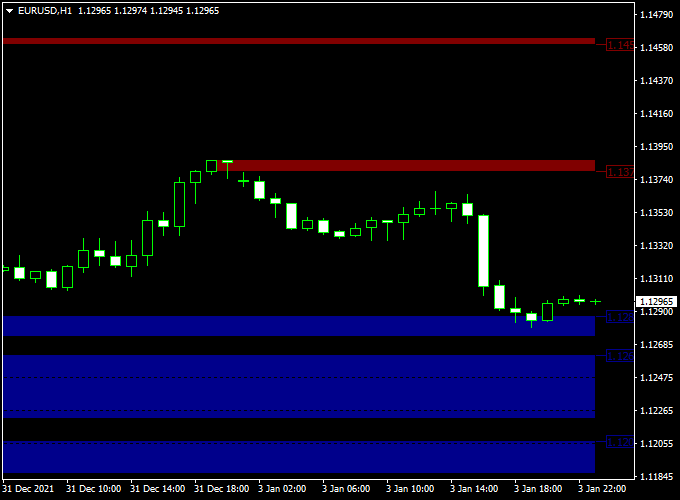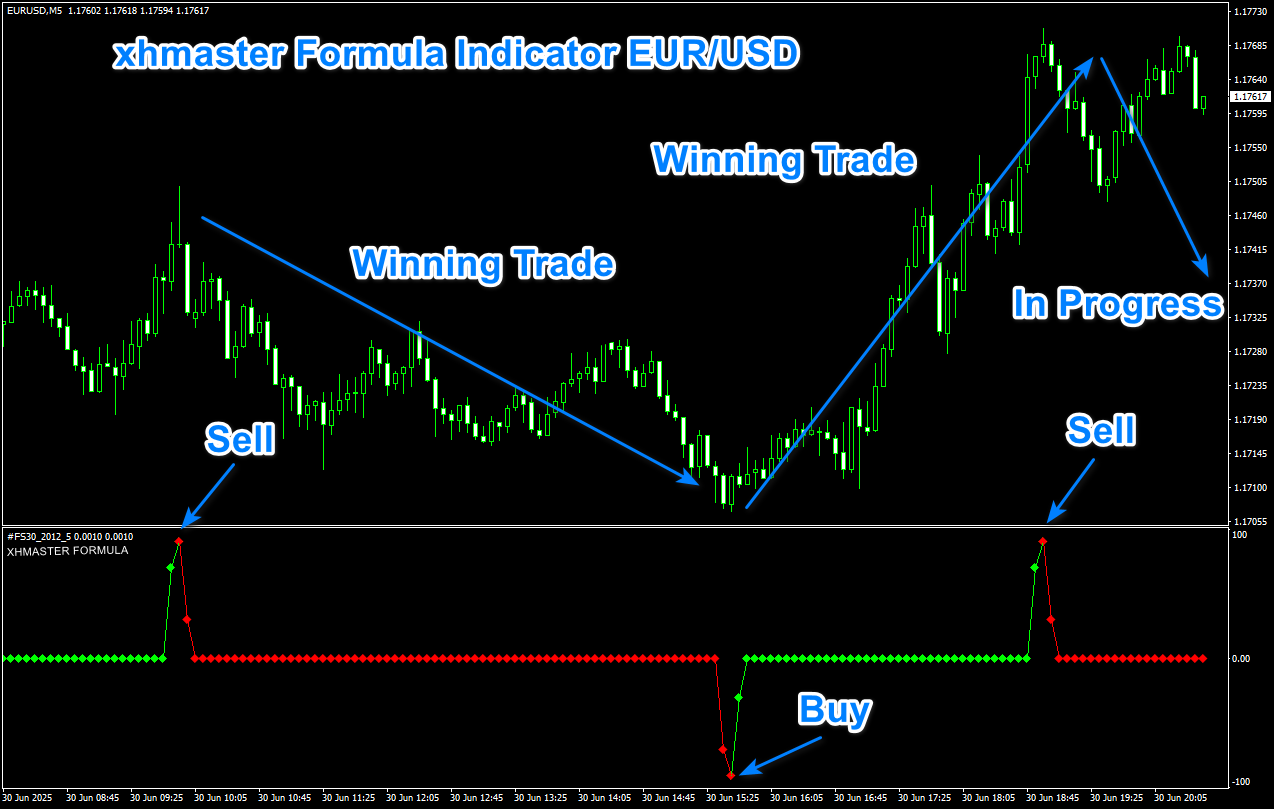The Supply & Demand Zones indicator for MT4 (Metatrader 4) draws the most significant zones of support and resistance on the chart.
The indicator pops up in the main MT4 chart window as blue and red colored zones.
The indicator is beginner-friendly and works out of the box.
Buy & Sell Trade Example
- In an uptrending market, look for buy trade entry in the blue supply zone.
- In a downtrending market, look for a sell trade entry in the red demand zone.
The Supply & Demand Zones indicator can be used for both trade entry and exit, or as an additional confirmation filter for other strategies and systems.
For scalping and day trading, the indicator performs best during the London and New York trading sessions.
The indicator works equally well on all currency pairs (majors, minors and exotic) and shows promising results if used correctly.
Free Download
Download the “i-supply-demand-zones.mq4” indicator for MT4
Indicator Chart (EUR/USD H1)
The example chart below displays the Supply & Demand Zones mt4 indicator in action on the trading chart.
Tips:
Feel free to use your own favorite trade entry, stop loss and take profit strategy to trade with the Supply & Demand Zones indicator.
As always, trade in agreement with the overall trend and practice on a demo account first until you fully understand this indicator.
Please note that even the best trading indicator cannot yield a 100% win rate over long periods.
Indicator Specifications & Inputs:
Trading Platform: Developed for Metatrader 4 (MT4)
Currency pairs: Works for any pair
Time frames: Works for any time frame
Trade Style: Works for scalping, day trading and swing trading
Input Parameters: Variable (inputs tab), color settings & style
Indicator type: Support & resistance
Does the indicator repaint? No.
Supply Demand Zones + Zero Lag MACD Intraday Strategy for MT4
This intraday trading strategy combines the Supply Demand Zones Indicator with the Zero Lag MACD Indicator for MT4.
It focuses on trading high-probability reversals or continuations from key support and resistance areas, while using MACD momentum to confirm direction.
The setup is simple to follow and offers reliable entries during active market hours.
The Supply Demand Zones Indicator automatically highlights important price areas where institutional buyers or sellers are likely to react.
The Zero Lag MACD Indicator then helps confirm momentum by showing a histogram above or below the zero line.
When both tools agree, the chance of catching a strong intraday move increases significantly.
This strategy works best on the M15 or M30 timeframes and suits traders who prefer clear structure and confirmation before entering the market.
It performs well on major pairs like EURUSD, GBPUSD, and gold, especially during the London and New York sessions.
Buy Entry Rules
- Wait for price to reach or bounce from a demand zone displayed by the Supply Demand Zones Indicator.
- Confirm that the Zero Lag MACD histogram is above the zero line, showing bullish momentum.
- Enter a buy trade at the open of the next candle after confirmation.
- Place the stop loss below the most recent demand zone or 10–15 pips below the entry.
- Set take profit near the next supply zone or at a 1.5 to 2 times risk-to-reward level.
- Optional: move stop loss to breakeven after gaining 15 pips in profit.
Sell Entry Rules
- Wait for price to reach or reject from a supply zone displayed by the Supply Demand Zones Indicator.
- Confirm that the Zero Lag MACD histogram is below the zero line, showing bearish momentum.
- Enter a sell trade at the open of the next candle after confirmation.
- Place the stop loss above the recent supply zone or 10–15 pips above the entry.
- Set take profit near the next demand zone or at a 1.5 to 2 times risk-to-reward level.
- Optional: secure partial profits when the trade reaches halfway to the target.
Advantages
- Combines price action zones with momentum confirmation for higher accuracy.
- Prevents premature entries by waiting for MACD agreement.
- Adaptable to different forex pairs and timeframes.
- Works best during trending intraday conditions with clear support and resistance zones.
- Helps visualize institutional order flow and reaction levels.
Drawbacks
- Less effective during flat or low-volume markets where zones overlap.
- Requires patience to wait for the right zone and MACD confirmation.
- False signals may occur if zones are weak or freshly formed.
- Best performance depends on proper zone sensitivity settings.
Example Case Study 1: EURUSD M15
During the London session, price touched a clearly defined demand zone at 1.0725.
The Zero Lag MACD histogram moved above zero on the next candle, confirming bullish momentum.
A buy trade was entered at 1.0730 with a stop loss at 1.0715.
The pair rallied toward the next supply zone at 1.0760, hitting take profit for a 30-pip gain within one hour.
Example Case Study 2: XAUUSD M30
In the early New York session, gold reached a strong supply zone near 2368.
The Zero Lag MACD histogram turned negative, showing bearish strength.
A sell was entered at 2365 with a stop loss at 2372 and a take profit at 2350.
The price dropped steadily, hitting the target for 15 pips profit per $1 move in gold within two hours.
Strategy Tips
- Trade only zones that are well-formed and recently respected by price.
- Wait for MACD confirmation before taking any position; this filters false breakouts.
- Focus on the first or second touch of a zone for stronger reactions.
- Avoid trading during major news events or low liquidity hours.
- Backtest the combination on multiple pairs to find optimal MACD parameters.
- Keep risk per trade small, ideally 1–2% of total account balance.
Download Now
Download the “i-supply-demand-zones.mq4” indicator for Metatrader 4







